 [picking
up from a previous page....] Election to another day in case
the lure of all those arrow-ventilated wagons kept his voters
at home.
[picking
up from a previous page....] Election to another day in case
the lure of all those arrow-ventilated wagons kept his voters
at home.
 [picking
up from a previous page....] Election to another day in case
the lure of all those arrow-ventilated wagons kept his voters
at home.
[picking
up from a previous page....] Election to another day in case
the lure of all those arrow-ventilated wagons kept his voters
at home.
Grim and dusty
Maverick was far more inclined to smirk at the whole po-faced Western genre, preferably from behind a winning Poker hand. James Garner was the devious card shark hero, a self-centred, smooth-talking ladies man more interested in fancy duds and serious violence-avoidance than truth, justice and the American way. Creator Roy Huggins gleefully sent up the whole rugged myth of the West, declaring: "I wanted to see how many rules we could break and get away with." Smart and deeply subversive, Maverick lurched into the mockery zone as soon as a bored scriptwriter told Garner to look at someone "with his beady little eyes". Garner duly milked the scene for cheap laughs, assorted camera crew types wet their britches and the smirk never left the show's face again.
Photo Caption: With promotional shots like this, it's not hard to believe that Cheyenne was shot on a measly budget.
Other small screen trail riders were altogether
grimmer. The bitterly realistic The Westerner was created
by Sam Peckinpah, later to direct the supremely gory late 60s
Western The Wild Bunch, a movie that kicked the whole noble
frontier myth to a senseless bloody pulp. Although lyrically shot,
The Westerner told tales of drifter killers and masochistic
hookers, all proving much too grisly to grab any ratings, it was
promptly dropped after one pitiless season, just as the networks
were wising up to the fact that the Western goldrush had become
a glut.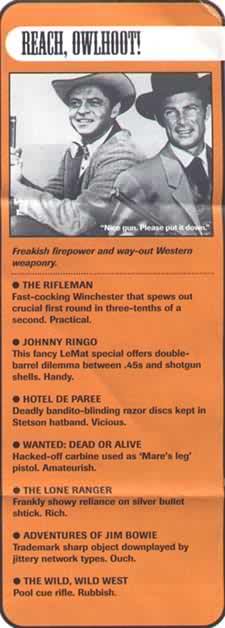
By the early 60s there were just too many buckskin escapades clogging the channels, with 31 new shows airing in a single season. The adult Western had also brought a controversial dose of violence to prime-time and, with Congress already holding hearings on the subject, network execs were under serious pressure to tone down the gunplay. Meanwhile, demographic-fixated advertisers had realised that the Westerns were only attracting the wrinklier end of viewerdom, while kids and wallet-unloading young adults were tuning into sitcoms. Sniffing dollar bills, the networks duly ditched their Johnny Ringos and pumped out the Gomer Pyles.
Family values
The West wasn't quite lost to the laugh track just yet, though. Just as the moody gunslingers holstered their .45s, TV saw a boom in sprawling, soapy family saga Westerns, big on slowly spoken fireside chats and endless manly hugs. Bonanza was the story of prosperous brood the Cartwrights, owners of the thousand square mile Ponderosa ranch, the largest expanse of land in Nevada territory.
Lorne Greene was widower Ben Cartwright, silvery patriarch to sons Adam, Little Joe and dumb, brawny Hoss, a lummox in a comedy Diddy Man hat left over from a Bob Hope movie that star Dan Blocker had originally slipped on only as a joke. Bonanza was male bonding incarnate--as creator David Dortort declared, "We do not have any moms built into our show--or, for that matter, any women. We are, as it were, anti-momism."
Over on ABC, Mom struck back in the fearsome form of Barbara Stanwyck, cattle queen of Montana in The Big Valley. Sadly, her 30,00 acre ranch was eminently mockable compared to the frankly belt-loosening Pondersoa.
As the 60s grew groovier, the TV Western
had a timely injection of hip to compete with the day-glo new
world of Pop Art and student protest. The Wild, Wild West
was a Bond-style slice of spy spoofery, complete with such anachronistic
gizmology as steam-powered robots and premature A-bombs. Sitcoms
Rango and F Troop clutched their aching sides at
the whole Western genre, while ranch saga The High Chaparral
followed America's changing cultural climate by treating the Apache
with dignity and respect, substituting snake-eyed rustlers for
six gun fodder. Another episode dealt with the plight of black
troops in the US Cavalry, just as movies like Soldier Blue
were soiling the golden myth of the boys with the flags and bugles.
The High Chaparral proved to be one of television's finest
Westerns, stylishly filmed in big-skied Tuscon and boasting a
truly rousing theme that made any man yearn to pose on a desert
cliff with a silhouetted Winchester.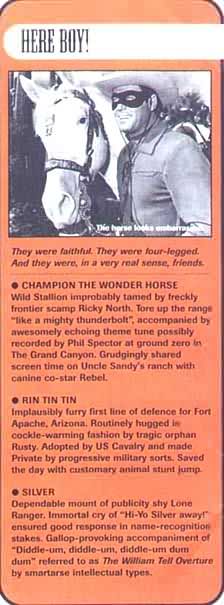
Last Chance Saloon
The 1970s saw the death of both the big- and small-screen Western, dying with its boots on but with tongue firmly embedded in cheek. While Redford and Newman traded quips before the final showdown in Butch Cassidy and The Sundance Kid, TV shamelessly rustled the film's buddy-buddy format and smirksome tone for Alias Smith and Jones. Ben Murphy and Pete Duel were Kid Curry and Hannibal Heyes, two outlaws aiming for a pardon by leading blameless lives for one impossible year. One of the last true Western hits, the series merrily sent up every hokey frontier cliche. Despite the show's success, star Pete Duel shot himself moments after watching an episode in his Hollywood apartment. He was replaced by Roger Davis, previously the show's twangy narrator.
The last gasp of 70s Westerns proved to be mighty strange. Kung Fu rode the insanely popular martial arts craze, as David Carradine roamed the Old West as Shaolin priest Kwai Chang Caine, muttering about "the oneness of all things" and troubled by candlelit flashbacks to egg-eyed types called him Grasshopper. Hec Ramsey, meanwhile, was a desperate attempt to compete with modern cop shows, with a frontier detective bringing newfangled methods–a magnifying glass–to turn-of-the-century Oklahoma. In 1974 film critic Pauline Kael declared, "The Western is dead". Little House on the Prairie debuted the same year. Go figure.
Still standing
Surviving sudsy 80s mini-series like Lonesome Dove and Paradise, and fiercely PC Young Guns-rip The Young Riders, the TV Western is now a grizzled Old Timer, reliving the mythical exploits of yesteryear in the ghost town of reruns. Now comes word of a new series based on the classic 1960 gunslinging flick The Magnificent Seven. Will the same screen walk tall once more? Polish your tin star and hope, hombre.
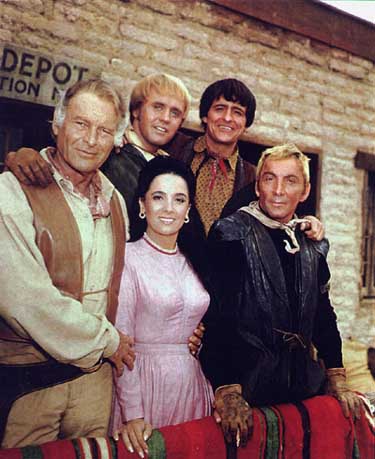 Photo
Caption: The High Chapparal managed to bring an element
of political correctness to a very unpolitically correct decade.
Photo
Caption: The High Chapparal managed to bring an element
of political correctness to a very unpolitically correct decade.
 Photo
Caption: Smith and Jones ponder a life where they won't have
to break the law.
Photo
Caption: Smith and Jones ponder a life where they won't have
to break the law.
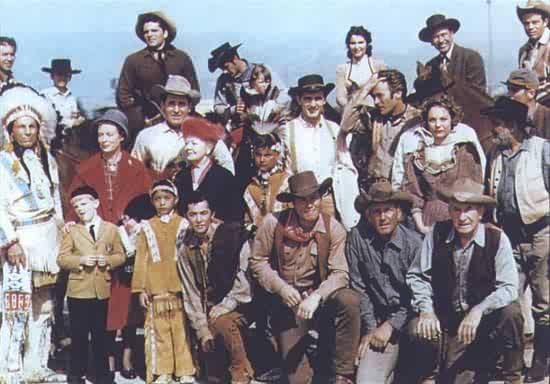 Photo
Caption: Confusion reigned when six Western shows accidentally
booked the same acre of Wild West space at the same time.
Photo
Caption: Confusion reigned when six Western shows accidentally
booked the same acre of Wild West space at the same time.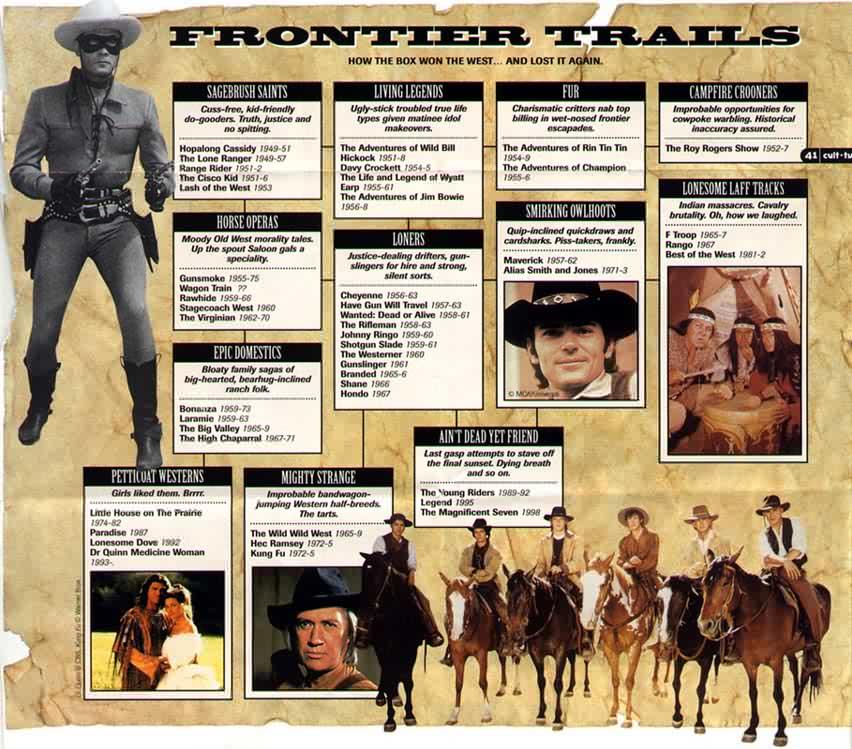
Back
to Articles List